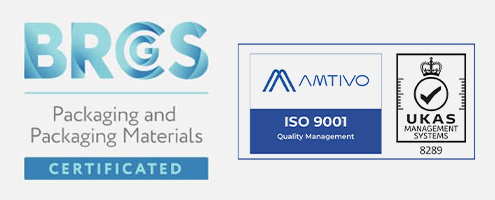Ever stopped to consider what happens to your plastic containers once they’ve served their purpose? Most non biodegradable plastic containers, after use, are discarded and end up in landfill sites; this has a major detrimental effect on the environment. But there’s a better way…
Biodegradable Plastic Containers
This isn’t some sci-fi invention; it’s an earth-friendly alternative that could revolutionise the packaging industry.
You’re probably wondering: Are these eco friendly food containers? Can I customise them for my business needs?
The answer is yes! And you’ll discover why as we dive deeper into this fascinating topic.
Benefits of Biodegradable Plastic Containers
The use of eco friendly packaging products is hugely beneficial, especially for food packaging products and offers significant cost savings, environmental sustainability, and product safety.
Economic Efficiency
Biodegradable plastic containers are not just eco-friendly alternatives; they are also a smart investment. While the initial production costs may be higher compared to traditional plastics, the long-term savings are substantial.
Avoiding potential fines or levies from the government due to non-compliant packaging materials? Check.
Charging a premium for green products that consumers love? Double-check.
Sustainability Champion
Bio-plastics, cost effective and rapidly decomposable without leaving any toxic residues behind, are an essential part of our effort to mitigate the effects of climate change due to plastic pollution. Unlike conventional plastics, which can take centuries to decompose, these bio-plastics break down within months under suitable conditions without leaving harmful residues behind (more info).
This means less waste clogging up our landfills and coastlines, making them an invaluable ally in our fight against the global impact of littered plastics caused by climate change.
A Safe Bet For Your Products
Going beyond economics and the environment, let’s not forget how MPS Europe’s range of biodegradable eco friendly food packaging containers offer excellent protection for your confectionery goods as well.
Our P.E.T (Polyethylene Terephthalate) containers boast a desirable combination of malleability and robustness, thereby safeguarding your products from any harm during transit or storage. They also provide a great user experience when opening them at home or in on-the-go situations where quick access is essential.
Note:The key statistics mentioned above demonstrate how switching from traditional packaging methods like glass jars or cans to biodegradable plastic containers can not only be more economical but also a safer choice overall. It allows you to preserve the quality that customers expect every time they purchase one of products wrapped in this innovative material solution. Our containers are designed to meet industry standards and consumer demands..
Key TakeawayChoosing biodegradable plastic containers for your sweets isn’t just eco-friendly, it’s savvy business. You’re eyeing long-term savings and avoiding possible government penalties. Plus, these bio-plastics deliver excellent protection for your treats while satisfying the environmentally conscious customer. It’s a win-win with one green move.
Unpacking the Quality Assurance of Biodegradable Plastic Containers
Quality assurance isn’t just a buzzword at MPS. Quality assurance is integral to our production of superior biodegradable plastic containers that meet stringent safety standards and support environmental sustainability.
We take pride in our responsibility for safeguarding environmental sustainability, and this is reflected in the dedication we have to providing superior-grade items that comply with rigorous safety criteria.
The Role of Rigorous Testing Procedures
Meticulous testing procedures are central to achieving consistent quality. These include mechanical tests such as tensile strength analysis and flexural modulus evaluation, along with chemical resistance checks to ensure container durability even when exposed to various substances.
We also conduct thermal stability assessments under diverse conditions, simulating real-world use scenarios. This helps us guarantee product reliability, no matter what your business needs may be.
Sustainability Considerations
Beyond functionality and safety features, sustainable sourcing is a significant aspect of our quality assurance procedures. The biopolymers used in manufacturing these containers are responsibly sourced, with careful consideration given to minimising our carbon footprint and reducing landfill waste.
Dedicated Team of Experts
To uphold these principles, we have established a dedicated team of experts who regularly review practices related to procurement, sourcing, and processing methodologies. Their primary responsibility lies in ensuring overall compliance while continuously striving for operational excellence. This further reinforces client trust over time.
Exploring Customisation Options for Biodegradable Plastic Containers
MPS Europe’s customisable biodegradable plastic containers are designed to cater to your specific product requirements. Our product range spans a wide spectrum, from the flexibility of size and shape to colour choices and lid options.
1. Embrace Size and Shape Flexibility
The versatility in our range allows you to select container dimensions that perfectly fit your needs – whether it be compact sizes for cosmetics or larger ones for industrial use. The power is in your hands.
In addition, we also offer shapes beyond standard round or square designs. If you’re looking for something unique that speaks volumes about your brand, our advanced manufacturing processes ensure no stone is left unturned when creating these bespoke forms.
2. Make Bold Choices with Colour Customisation
We understand the importance of branding; consequently, we offer complete freedom in choosing the colour of your PET containers – transparent if you want the product inside visible or vibrant colours that align with company guidelines.
We only use environmentally friendly colorants during production, ensuring both vibrancy and adherence to sustainability standards. This means not just appealing packaging, but also a positive contribution towards environmental conservation.
3. Pick Your Perfect Lid
Lid selection plays a pivotal role in impacting usability significantly; therefore, MPS Europe offers various eco-friendly lid types, including screw tops ideal for liquids, flip-top lids perfect for dispensing creams, and press-on lids suitable for an air-tight seal. Learn more about our variety of lid options here.
Key TakeawayMPS Europe’s biodegradable plastic containers for food and confectionary let you enjoy the best of both worlds. You’re not stuck with a standard size; these are fully customizable. They offer perfect-fit sizes, unique shapes, vibrant colours and green lids – they’ve thought of everything.
FAQs About Biodegradable PET Plastic Containers
What are biodegradable containers?
Biodegradable containers are made from plant-based materials that decompose naturally over time, reducing environmental impact compared to traditional plastic.
Are plastic food containers biodegradable?
Not all plastic food containers are biodegradable. However, those crafted specifically from plant-derived polymers can degrade organically without leaving harmful residues.
Are biodegradable food containers safe?
Absolutely. Biodegradable food containers undergo rigorous testing to ensure they’re non-toxic and safe for storing edibles while meeting strict quality standards.
Is biodegradable packaging more expensive?
The initial cost of producing biodegradable packaging may be higher than regular plastics, but the long-term benefits such as reduced waste disposal costs balance it out.
So, you’ve learned the benefits of Biodegradable Plastic Containers. These eco-friendly heroes can save your business money and help protect our planet.
You now know that quality assurance isn’t a concern with these containers. They’re as reliable as they come!
And remember how we spoke about customization? Yes, it’s possible to tailor these containers to perfectly fit your unique needs.
Biodegradable plastic containers are not just an environmentally friendly choice but also a smart business decision. And who doesn’t love a win-win?
MPS Europe is here for all your confectionery packaging needs. We offer moulded P.E.T biodegradable plastic containers that are safe, cost-effective, and environmentally friendly.
Visit MPS Europe, today, and let’s work together towards creating sustainable solutions for our world!

